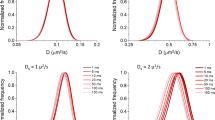Abstract.
A generalized transport model is derived for cell migration in an anisotropic environment and is applied to the specific cases of biased cell migration in a gradient of a stimulus (taxis; e.g., chemotaxis or haptotaxis) or along an axis of anisotropy (e.g., contact guidance). The model accounts for spatial or directional dependence of cell speed and cell turning behavior to predict a constitutive cell flux equation with drift velocity and diffusivity tensor (termed random motility tensor) that are explicit functions of the parameters of the underlying random walk model. This model provides the connection between cell locomotion and the resulting persistent random walk behavior to the observed cell migration on longer time scales, thus it provides a framework for interpreting cell migration data in terms of underlying motility mechanisms.
Similar content being viewed by others
Author information
Authors and Affiliations
Additional information
Received: 8 April 1999
Rights and permissions
About this article
Cite this article
Dickinson, R. A generalized transport model for biased cell migration in an anisotropic environment. J Math Biol 40, 97–135 (2000). https://doi.org/10.1007/s002850050006
Issue Date:
DOI: https://doi.org/10.1007/s002850050006




